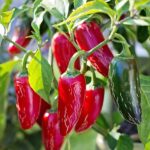Peppers, with their vibrant colours and diverse flavours, are a staple in cuisines around the world. From mild bell peppers to fiery jalapenos, there’s a pepper variety to suit every taste bud. But why settle for store-bought peppers when you can grow your own? In this comprehensive guide, we’ll take you through the ins and outs of growing peppers, from seed to harvest, and help you cultivate a b ountiful pepper patch right in your backyard.
Understanding Peppers:
Before we dive into the nitty-gritty of pepper cultivation, let’s take a moment to appreciate the plant itself. Peppers belong to the nightshade family, Solanaceae, and are native to Central and South America. They come in a wide range of shapes, sizes, colors, and heat levels, thanks to centuries of cultivation and selective breeding by humans.
Choosing the Right Pepper Varieties:
When it comes to peppers, variety is the spice of life. Before you start planting, consider which types of peppers you’d like to grow. Are you a fan of sweet bell peppers for salads and stir-fries? Or do you prefer the fiery kick of habaneros or ghost peppers? There are hundreds of pepper varieties to choose from, so take your time and select ones that match your taste preferences and growing conditions.
Preparing the Soil:
Like most plants, peppers thrive in well-drained, fertile soil. Before planting, amend your soil with organic matter such as compost or aged manure to improve its structure and fertility. Peppers prefer slightly acidic soil with a pH level between 6.0 and 6.8, so consider testing your soil and adjusting the pH if necessary. Ensure that the planting area receives plenty of sunlight, as peppers love the warmth and need at least 6-8 hours of sunlight per day.
Planting Peppers:
Once you’ve prepared the soil, it’s time to get planting. Start your pepper seeds indoors 6-8 weeks before your last expected frost date. Use seed trays or small pots filled with seed starting mix, and plant the seeds ¼ inch deep. Keep the soil moist and warm, and the seeds should germinate within 7-10 days. Once the seedlings have developed their first true leaves, transplant them into larger pots or directly into the garden bed.
When planting pepper seedlings outdoors, space them 18-24 inches apart in rows spaced 24-36 inches apart. Water the seedlings thoroughly after planting, and mulch around the base of the plants to help retain moisture and suppress weeds.
Caring for Your Pepper Plants:
Growing peppers is relatively low-maintenance, but they do require some care to thrive. Here are a few tips to keep your pepper plants
happy and healthy:
Watering:
Peppers need regular watering, especially during hot, dry weather. Keep the soil consistently moist but not waterlogged, as overly wet soil can lead to root rot.
Fertilizing:
Feed your pepper plants with a balanced fertilizer every 4-6 weeks throughout the growing season. Avoid high-nitrogen fertilizers, as they can promote excessive foliage growth at the expense of fruit production.
Supporting Your Plants:
Some pepper varieties, especially those with large fruit, may benefit from staking or trellising to support the weight of the plants. Use bamboo stakes or tomato cages to keep the plants upright and prevent them from sprawling on the ground.

Pruning:
While not necessary, pruning can help improve airflow and light penetration, leading to healthier plants and better fruit production. Pinch off any small shoots that develop in the leaf axils, as well as any damaged or diseased foliage.
Harvesting Your Peppers:
As the summer progresses, your pepper plants will begin to produce fruit. Peppers can be harvested at any stage of ripeness, from green to fully mature, depending on your preferences. Simply grasp the pepper gently and twist it from the plant, taking care not to damage the stem or surrounding foliage. Most peppers will continue to ripen after being picked, so if you prefer sweeter, more flavorful peppers, leave them on the plant until they reach their desired colour.
Conclusion:
Growing peppers at home is a rewarding experience that allows you to enjoy the freshest, most flavorful peppers possible. Whether you’re a novice gardener or a seasoned pro, there’s nothing quite like the satisfaction of harvesting your homegrown peppers straight from the garden. So roll up your sleeves, dig in the dirt, and get ready to embark on a flavorful journey with your pepper plants!





